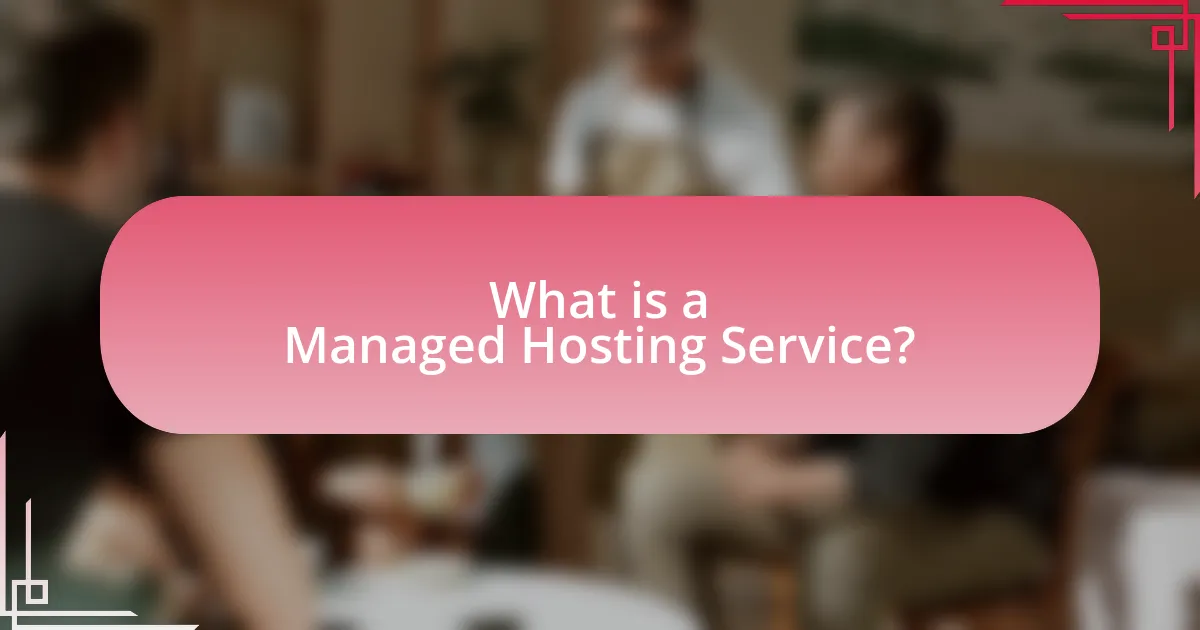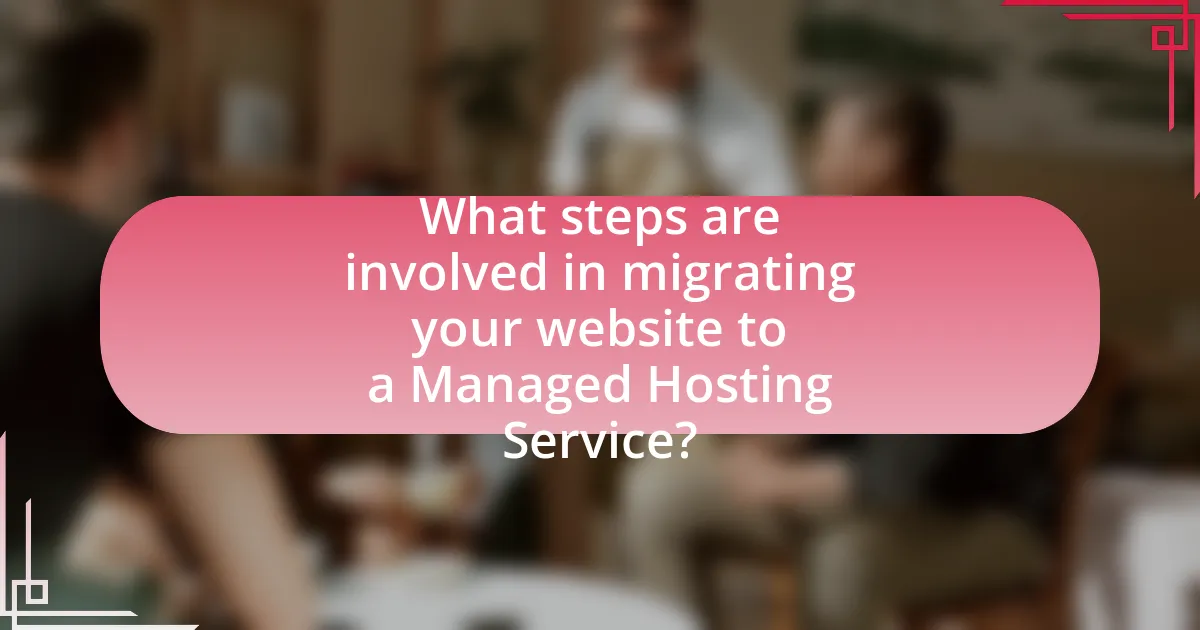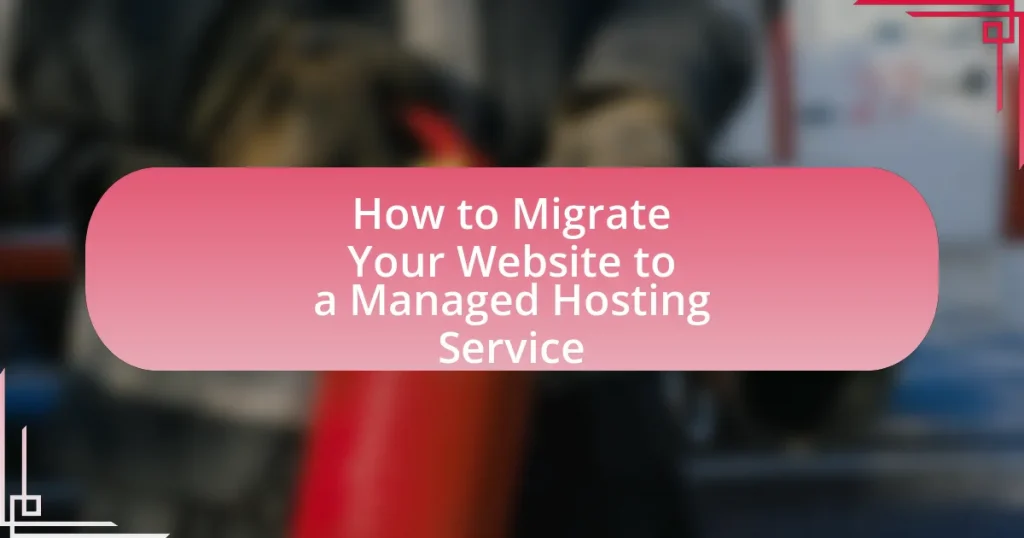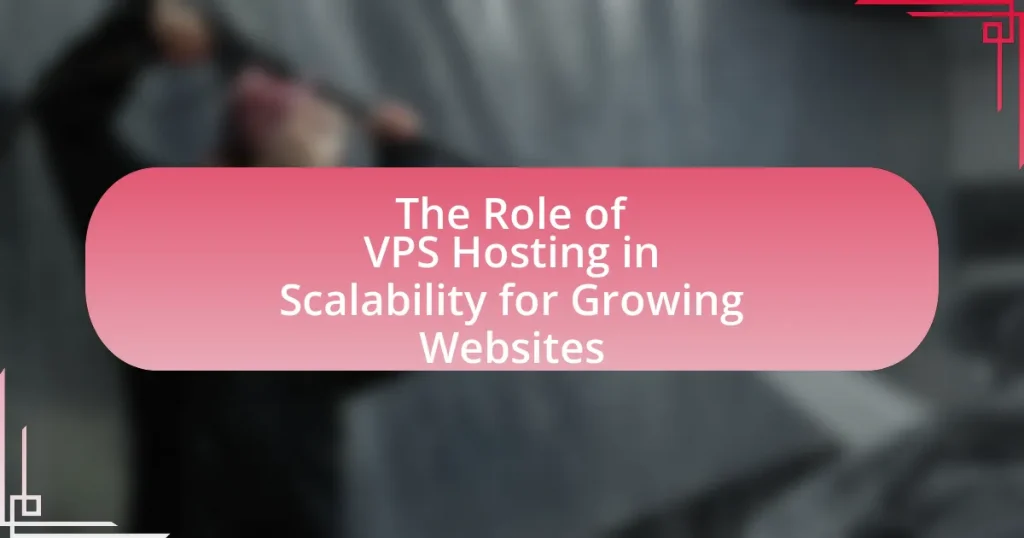A Managed Hosting Service is a web hosting solution where the provider manages server maintenance, security, and support, allowing businesses to concentrate on their core operations. This article outlines the differences between managed and traditional hosting, key features of managed services, and the benefits of migrating to such a service, including enhanced performance and security. It details the steps involved in the migration process, from planning and data backup to transferring files and testing the new environment, while also addressing common challenges and best practices to ensure a smooth transition. Additionally, it emphasizes the importance of ongoing maintenance and provides tips for streamlining the migration process.

What is a Managed Hosting Service?
A Managed Hosting Service is a type of web hosting where the service provider takes care of the management of the server, including maintenance, security, and support. This allows businesses to focus on their core activities without worrying about server management tasks. Managed hosting typically includes features such as automatic backups, software updates, and technical support, which enhance the reliability and performance of hosted websites. According to a report by MarketsandMarkets, the managed hosting market is expected to grow significantly, indicating a rising demand for these services due to their efficiency and convenience.
How does a Managed Hosting Service differ from traditional hosting?
A Managed Hosting Service differs from traditional hosting primarily in the level of management and support provided. In managed hosting, the service provider takes care of server management, maintenance, security, and updates, allowing businesses to focus on their core activities. In contrast, traditional hosting typically requires users to manage their own server configurations, software updates, and security measures, which can lead to increased complexity and potential vulnerabilities. This distinction is significant as it impacts operational efficiency and resource allocation for businesses.
What are the key features of Managed Hosting Services?
Managed Hosting Services offer several key features, including dedicated resources, enhanced security, and expert support. Dedicated resources ensure that clients have exclusive access to server capabilities, which improves performance and reliability. Enhanced security measures, such as firewalls and regular backups, protect sensitive data from threats. Additionally, expert support provides 24/7 assistance from IT professionals, ensuring quick resolution of issues and optimal server management. These features collectively contribute to a more efficient and secure hosting environment, making managed hosting a preferred choice for businesses seeking reliable web solutions.
Why might a business choose Managed Hosting over other options?
A business might choose Managed Hosting over other options due to its comprehensive support and maintenance services. Managed Hosting providers handle server management, security updates, and performance optimization, allowing businesses to focus on their core operations without the burden of technical issues. According to a study by HostingAdvice, 70% of businesses reported improved performance and reduced downtime after switching to Managed Hosting, highlighting its effectiveness in enhancing operational efficiency.
What are the benefits of migrating to a Managed Hosting Service?
Migrating to a Managed Hosting Service offers several benefits, including enhanced performance, improved security, and reduced operational burden. Managed Hosting Services provide optimized server configurations and resources tailored to specific applications, resulting in faster load times and better user experiences. Additionally, these services often include robust security measures such as firewalls, DDoS protection, and regular security updates, which help safeguard sensitive data. Furthermore, by outsourcing server management tasks to experts, businesses can focus on their core operations rather than IT maintenance, leading to increased productivity and efficiency.
How can Managed Hosting improve website performance?
Managed hosting improves website performance by providing dedicated resources and optimized server configurations tailored to specific applications. This ensures faster load times, reduced downtime, and enhanced scalability. For instance, managed hosting services often utilize Content Delivery Networks (CDNs) and caching mechanisms, which can decrease latency and improve user experience. Additionally, the proactive monitoring and maintenance offered by managed hosting providers help identify and resolve performance issues before they impact users, leading to a more reliable and efficient website.
What security advantages does Managed Hosting provide?
Managed Hosting provides enhanced security advantages, including regular security updates, dedicated firewalls, and proactive monitoring. These features ensure that the server environment is consistently protected against vulnerabilities and threats. For instance, managed hosting providers often implement automated patch management, which reduces the risk of exploitation from outdated software. Additionally, many providers offer DDoS protection and intrusion detection systems, which further safeguard against malicious attacks. This comprehensive security approach is crucial for maintaining data integrity and compliance with regulations, such as GDPR or HIPAA, which require stringent data protection measures.

What steps are involved in migrating your website to a Managed Hosting Service?
The steps involved in migrating your website to a Managed Hosting Service include planning the migration, selecting a suitable managed hosting provider, backing up your existing website, transferring files and databases, configuring the new environment, testing the website on the new server, and finally updating DNS settings.
Planning the migration involves assessing your current website’s requirements and determining the best managed hosting solution. Selecting a suitable provider requires evaluating features, performance, and support options. Backing up your existing website ensures that all data is preserved during the transition. Transferring files and databases can be done using FTP or migration tools provided by the hosting service. Configuring the new environment includes setting up server settings and installing necessary software. Testing the website on the new server is crucial to ensure functionality before going live. Updating DNS settings directs traffic to the new server, completing the migration process.
How do you prepare for the migration process?
To prepare for the migration process, conduct a comprehensive audit of your current website, including its content, structure, and performance metrics. This audit helps identify essential elements that need to be transferred and any potential issues that may arise during migration. Additionally, create a detailed migration plan that outlines the steps involved, including data backup, DNS changes, and testing protocols. According to a study by the Content Marketing Institute, 70% of successful migrations involve thorough planning and testing, which minimizes downtime and data loss.
What data should you back up before migration?
Before migration, you should back up website files, databases, and configuration settings. Website files include all HTML, CSS, JavaScript, and media files that make up the site. Databases contain critical data such as user information, content, and settings, typically stored in systems like MySQL or PostgreSQL. Configuration settings encompass server settings, application configurations, and any custom scripts. Backing up this data ensures that you can restore your website to its previous state in case of any issues during the migration process.
How do you choose the right Managed Hosting provider?
To choose the right Managed Hosting provider, evaluate their performance, support, scalability, and security features. Performance is critical; look for providers with high uptime guarantees, ideally above 99.9%, and fast server response times. Support should be 24/7 and include multiple channels like chat, email, and phone, ensuring assistance is readily available. Scalability is essential for future growth; select a provider that allows easy upgrades to accommodate increased traffic or resource needs. Security features must include regular backups, SSL certificates, and DDoS protection to safeguard your data. According to a 2022 survey by HostingAdvice, 70% of users prioritize customer support and uptime when selecting a hosting provider, underscoring the importance of these factors in making an informed choice.
What are the technical steps to migrate your website?
To migrate your website, follow these technical steps: first, back up your existing website files and database to ensure data safety. Next, choose a managed hosting service that meets your needs and set up your new hosting account. After that, upload your website files to the new server using FTP or a file manager, and import your database using a tool like phpMyAdmin. Update your website’s configuration files to reflect the new database credentials and server settings. Finally, change your domain’s DNS settings to point to the new hosting provider, and test your website to ensure everything functions correctly. These steps are essential for a successful migration, as they minimize downtime and data loss.
How do you transfer your website files and databases?
To transfer your website files and databases, use an FTP client to upload files to the new server and export/import databases using tools like phpMyAdmin. The FTP client connects to your current hosting service, allowing you to download files, which you then upload to the new managed hosting service. For databases, export the database from the old server and import it into the new server using phpMyAdmin or command-line tools. This method is widely used and ensures that all files and data are accurately transferred, maintaining the integrity of your website.
What configurations need to be updated post-migration?
Post-migration, the configurations that need to be updated include DNS settings, database connection strings, and application environment variables. DNS settings must be adjusted to point to the new server’s IP address to ensure users reach the migrated site. Database connection strings require updates to reflect the new database server’s credentials and location. Additionally, application environment variables should be configured to align with the new hosting environment, ensuring that the application functions correctly with the updated infrastructure.

What challenges might you face during the migration process?
During the migration process to a managed hosting service, common challenges include data loss, downtime, and compatibility issues. Data loss can occur if backups are not properly managed or if files are corrupted during transfer. Downtime may result from DNS propagation delays or server configuration errors, impacting website accessibility. Compatibility issues can arise if the new hosting environment differs significantly from the previous one, affecting website functionality or performance. These challenges are well-documented in migration case studies, highlighting the importance of thorough planning and testing to mitigate risks.
How can you troubleshoot common migration issues?
To troubleshoot common migration issues, first identify the specific problem, such as downtime, data loss, or broken links. Next, verify that all files and databases have been correctly transferred and that configurations match the new environment. For instance, check DNS settings to ensure they point to the new server and confirm that all necessary permissions are set correctly. Additionally, utilize error logs to diagnose issues and run tests to confirm functionality. According to a study by the HostingAdvice team, 70% of migration issues stem from misconfigured settings, highlighting the importance of thorough checks during the process.
What are the most frequent errors encountered during migration?
The most frequent errors encountered during migration include data loss, broken links, and misconfigured settings. Data loss often occurs due to incomplete backups or failure to transfer all files, which can lead to missing content on the new platform. Broken links typically arise when URLs change during the migration process, resulting in 404 errors that negatively impact user experience and SEO. Misconfigured settings, such as incorrect database connections or server configurations, can lead to website downtime or functionality issues post-migration. These errors highlight the importance of thorough planning and testing during the migration process to ensure a smooth transition to a managed hosting service.
How can you ensure minimal downtime during the migration?
To ensure minimal downtime during migration, implement a phased migration strategy that includes pre-migration testing, DNS management, and a rollback plan. Pre-migration testing allows you to identify potential issues before the actual migration, reducing the risk of unexpected downtime. Effective DNS management, such as lowering the TTL (Time to Live) before migration, ensures that changes propagate quickly, minimizing the time users experience downtime. Additionally, having a rollback plan in place allows for immediate restoration to the previous state if any critical issues arise during the migration process, further safeguarding against extended downtime.
What best practices should you follow for a successful migration?
To ensure a successful migration to a managed hosting service, it is essential to conduct thorough planning and testing. This involves creating a detailed migration plan that outlines each step of the process, including data backup, DNS changes, and application compatibility checks. Additionally, performing a test migration can help identify potential issues before the actual migration, allowing for adjustments to be made. According to a study by the Cloud Industry Forum, 70% of organizations that planned their migration process reported fewer disruptions and a smoother transition.
How can you test your website after migration to ensure everything works?
To test your website after migration and ensure everything works, conduct a comprehensive checklist that includes functionality testing, performance testing, and SEO checks. Functionality testing involves verifying that all links, forms, and interactive elements operate correctly, while performance testing assesses page load times and server response. SEO checks ensure that metadata, sitemaps, and robots.txt files are correctly configured. According to a study by Google, 53% of mobile users abandon sites that take longer than three seconds to load, highlighting the importance of performance testing. Additionally, using tools like Google Search Console can help identify any SEO issues post-migration.
What ongoing maintenance should you consider after migrating?
After migrating to a managed hosting service, ongoing maintenance should include regular backups, security updates, performance monitoring, and content management. Regular backups ensure data recovery in case of failures, while security updates protect against vulnerabilities. Performance monitoring helps identify issues that may affect user experience, and content management ensures that the website remains relevant and up-to-date. These practices are essential for maintaining website integrity and functionality in a managed hosting environment.
What tips can help streamline your migration to a Managed Hosting Service?
To streamline your migration to a Managed Hosting Service, begin by conducting a thorough assessment of your current infrastructure and requirements. This assessment allows you to identify specific needs such as bandwidth, storage, and security features, ensuring that the chosen service aligns with your operational demands. Additionally, creating a detailed migration plan that outlines timelines, responsibilities, and potential risks can significantly reduce downtime and complications during the transition. Engaging with the Managed Hosting provider early in the process facilitates better communication and support, as they can offer tailored solutions and resources to assist with the migration. Finally, performing comprehensive testing post-migration ensures that all functionalities are working as intended, which is crucial for maintaining service quality.















